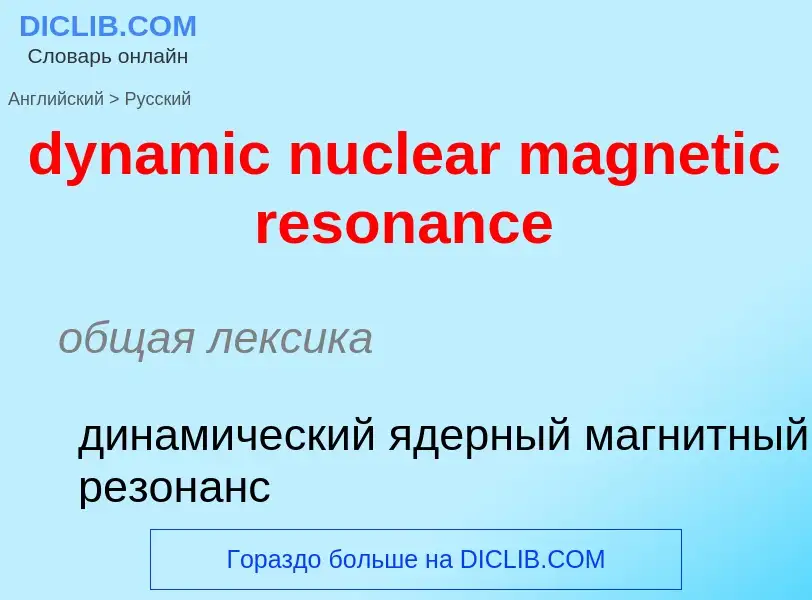Tradução e análise de palavras por inteligência artificial ChatGPT
Nesta página você pode obter uma análise detalhada de uma palavra ou frase, produzida usando a melhor tecnologia de inteligência artificial até o momento:
- como a palavra é usada
- frequência de uso
- é usado com mais frequência na fala oral ou escrita
- opções de tradução de palavras
- exemplos de uso (várias frases com tradução)
- etimologia
dynamic nuclear magnetic resonance - tradução para russo
общая лексика
динамический ядерный магнитный резонанс
динамический ЯМР
общая лексика
ядерная магнитно-резонансная спектроскопия
ЯМР-спектроскопия
синоним
медицина
магнитно-резонансная спектроскопия
Definição
Wikipédia
Nuclear magnetic resonance (NMR) in the geomagnetic field is conventionally referred to as Earth's field NMR (EFNMR). EFNMR is a special case of low field NMR.
When a sample is placed in a constant magnetic field and stimulated (perturbed) by a time-varying (e.g., pulsed or alternating) magnetic field, NMR active nuclei resonate at characteristic frequencies. Examples of such NMR active nuclei are the isotopes carbon-13 and hydrogen-1 (which in NMR is conventionally known as proton NMR). The resonant frequency of each isotope is directly proportional to the strength of the applied magnetic field, and the magnetogyric or gyromagnetic ratio of that isotope. The signal strength is proportional both to the stimulating magnetic field and the number of nuclei of that isotope in the sample. Thus in the 21 tesla magnetic field that may be found in high resolution laboratory NMR spectrometers, protons resonate at 900 MHz. However, in the Earth's magnetic field the same nuclei resonate at audio frequencies of around 2 kHz and generate very weak signals.
The location of a nucleus within a complex molecule affects the 'chemical environment' (i.e. the rotating magnetic fields generated by the other nuclei) experienced by the nucleus. Thus different hydrocarbon molecules containing NMR active nuclei in different positions within the molecules produce slightly different patterns of resonant frequencies.
EFNMR signals can be affected by both magnetically noisy laboratory environments and natural variations in the Earth's field, which originally compromised its usefulness. However this disadvantage has been overcome by the introduction of electronic equipment which compensates changes in ambient magnetic fields.
Whereas chemical shifts are important in NMR, they are insignificant in the Earth's field. The absence of chemical shifts causes features such as spin-spin multiplets (that are separated by high fields) to be superimposed in EFNMR. Instead, EFNMR spectra are dominated by spin-spin coupling (J-coupling) effects. Software optimised for analysing these spectra can provide useful information about the structure of the molecules in the sample.





![<sup>1</sup>H NMR spectrum of [[menthol]] with [[chemical shift]] in ppm on the horizontal axis. Each magnetically inequivalent proton has a characteristic shift, and couplings to other protons appear as splitting of the peaks into multiplets: e.g. peak ''a'', because of the three magnetically equivalent protons in methyl group ''a'', couple to one adjacent proton (''e'') and thus appears as a doublet. <sup>1</sup>H NMR spectrum of [[menthol]] with [[chemical shift]] in ppm on the horizontal axis. Each magnetically inequivalent proton has a characteristic shift, and couplings to other protons appear as splitting of the peaks into multiplets: e.g. peak ''a'', because of the three magnetically equivalent protons in methyl group ''a'', couple to one adjacent proton (''e'') and thus appears as a doublet.](https://commons.wikimedia.org/wiki/Special:FilePath/Menthol Proton Spectrum.jpg?width=200)
